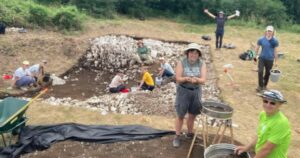Picture a blacksmith, laboring over his forge over 2,000 years ago. Think of the heat from his fire that scorched the daubed wall behind it. Imagine the iron shavings that flew off the hot metal he hammered. Hear the clang of each hit, and the murmur of the voices of the fort he serves.
It’s not hard for Laura Spear to see that image. In fact, it was her job this summer.
“A lot of archaeologists are not able to see past the artifacts and see the people who used them,” she mused. “Ask yourself, are you thinking about who these people are and what these artifacts you’re finding mean?”
Spear, an UWM anthropology and classics major, and her schoolmate, graduate student Calleigh Wondra, were part of a cohort of budding archaeologists who spent their summer in Slovenia excavating the remains of an Iron Age hill fort. And yes, they’re fairly certain they uncovered what used to be a blacksmith’s workshop over the course of their work.
The excavation project, whimsically named “The Wolves and the Caesars,” was led by Adrienne Frie, an assistant professor of anthropology at UW-Oshkosh, and UW- Oshkosha assistant teaching professor of anthropology Kevin Garstki. They collaborated with researchers from the National Museum of Slovenia and the Slovenian Institute of Archaeology to not only lead students in the excavation, but also to deliver lectures on anthropology and the technology of archaeology.
The students, hailing from several UW System schools and from the University of Mississippi, earned course credit for the five weeks they spent abroad. They split their time working on the dig site in the morning and attending lectures in the afternoon. On the weekends, they traveled around Slovenia, exploring as tourists.
“Since we’re doing digital archaeology, we had groups for digging, and groups for LiDAR and photogrammetry,” explained Wondra, who is working toward her Master’s in anthropology with a focus on museum studies. The students sectioned off in thirds and rotated through the three groups every three days. LiDAR is a technology that maps topography using lasers, and photogrammetry uses photography to obtain information about the environment, such as the distance between objects.
“The first week, we were out digging to get the turf off the ground, which is the first layer of dirt that would have built up over time,” Wondra said. “After breakfast, (we would) go down to the hill and climb with all of our stuff. … Carrying that equipment up the hill was not too sexy.”
As they dug, they often uncovered artifacts that they catalogued on site. Evidence suggests that the hill fort was abandoned around 100 BCE, and was probably used by the Celts for a few centuries before that.
But what is a hill fort, exactly?
“It’s a fortress that has been built to encompass the plateau of the hill,” Spear said. “These fortresses were not just sitting alone; they would have had satellite communities around them or even a large community at the base. It’s not exactly a castle and medieval village, but it’s a well-fortified area that would be able to easily defend the communities if need be.”
This is the first time this particular hill fort has been excavated. Wondra recounted how some of the locals would come to talk with the students about their work and learn more about the dig site. She also laughs when she recalls the close quarters.
“We were in a circular pit. We were so close together because there was nowhere to go,” she said.
There were also some surprising discoveries – namely, the blacksmith’s workshop.
“We were not expecting to find the blacksmith’s shop where we did,” Spear admitted. She originally thought that having a building that is “constantly on fire” would be dangerous and that it might be located farther away from the fort.
“But we ended up finding it in the opposite area, smackdab in the middle of a bunch of other buildings,” she said. The clues were undeniable: There were scorch marks from the forge on daub, a type of ancient insulation; an abundance of an iron-rich stone called hematite; and most telling of all, iron slag, a byproduct of metal-working.
It was an important lesson, said Spear.
“You need to be ready for your theories to be totally wrong,” she said.
And just as importantly, she said, you need to remember why you’re digging in the first place.
“Once a person dies, they are completely vulnerable to the people around them. That vulnerability, as we’ve seen throughout the centuries, has been taken advantage of. Being the person to intervene between (them) those who would want to take advantage of these civilizations, I think is good.”
By Sarah Vickery, College of Letters & Science
